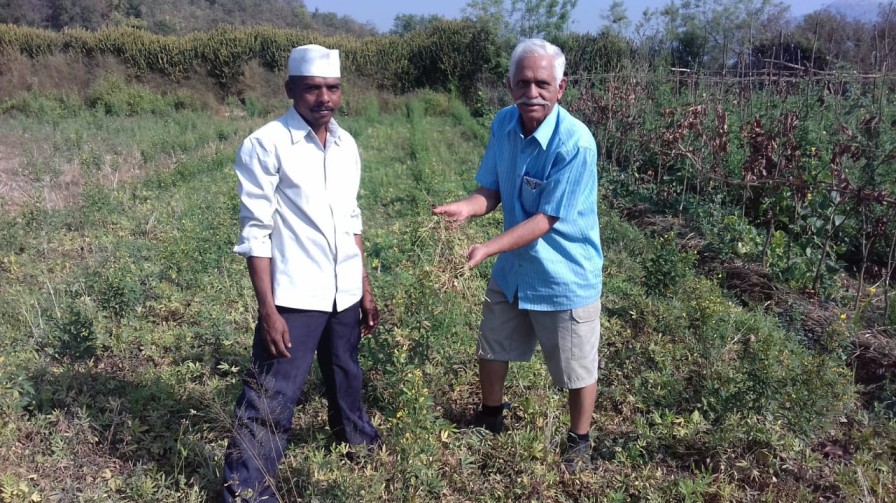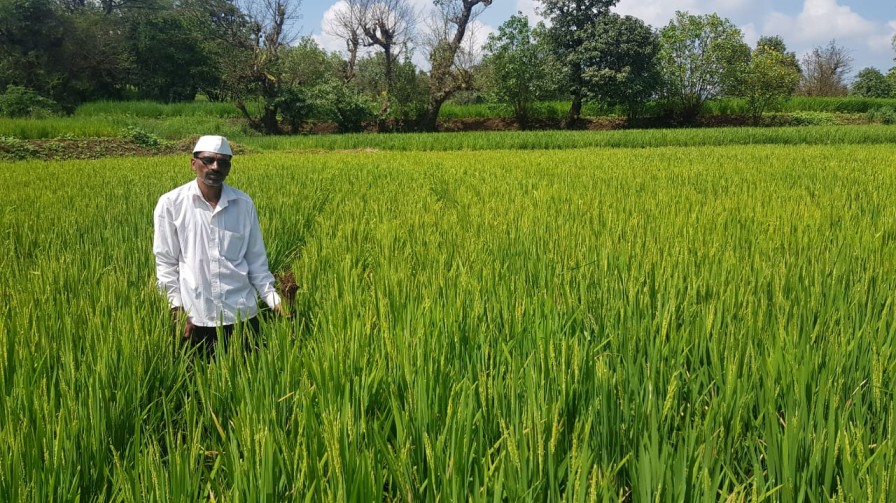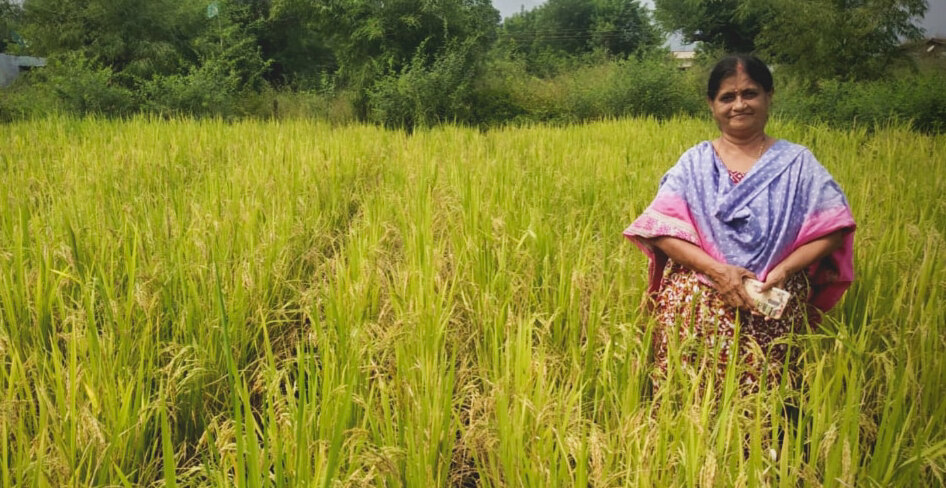71-YO Farmer’s Unique Technique Helps 4,000 Others Earn Profits Without Tilling
Food scientist-turned-farmer, Chandrasekhar Bhadsavle, fondly addressed by farmers as ‘Dada’, introduced the Saguna Rice Technique (SRT) among a handful of farmers in Neral (Karjat) in 2013. Today, it is practised by progressive farmers in all the 16 agro-climatic zones of Maharashtra.

With every sowing season, more farmers in Maharashtra are adopting a climate-positive technique to grow crops which, besides bringing down labour costs, it assures a good harvest. This is all thanks to a pioneering innovation by food scientist-turned-farmer, Chandrasekhar Bhadsavle, fondly addressed by farmers as ‘dada’.
Introduced among a handful of farmers in Neral (Karjat) in 2013, the technique called SRT (Saguna Rice Technique) is being practised by progressive farmers in all the 16 agro-climatic zones of Maharashtra. Incidentally, it gets its name from India’s first agro-tourism initiative, ‘Saguna Baug’, which is located 75 km from Mumbai.
Bhadsavle, now 71, graduated from Dr Balasaheb Sawant Konkan Krishi Vidyapeeth, acquired his master’s degree in food sciences and technology from the University of California and worked in various food-related companies there. Having returned to India in 1976 at the bidding of his father, he went ahead to establish the Baug, spread over 55 acres.
Boon For Water Scare Areas

Despite the region receiving heavy rainfall and being endowed with fertile soil, most farmers here have abandoned farming, selling their farm plots to mushrooming townships and migrating to the urban centres to eke out their livelihoods. Once a degraded land, the Baug is an inspiring story of a productive farm that has persisted in tapping the region’s natural strengths to grow food crops, bamboo, rear livestock and fish, and promote the surrounding wild biodiversity. The creation of six rain-fed ponds, which is spread on 9 acres, the sprawling canopy cover and fields lush with standing crops are testimony to its success which brings in inquisitive farmers and urban tourists visiting it in hordes.
“I have been working on the SRT technique for long, perfecting it on the farmlands of Saguna,” informs Bhadsavale, his snow-white rolled finger moustache prominent on his face and a Stetson on his head. “It’s being used for summer and monsoon crops and also to grow vegetables, pulses etc,” he adds.
Agriculture, mainly being rain-fed in India, is vulnerable to the vagaries of climate change. Growing paddy, a water-intensive crop, involves deep ploughing and puddling of soil, followed by transplantation of the seedlings. Ploughing loosens the topsoil. Farmers over generations have lived under an erroneous belief that the crop would be good only if the land is ploughed well. Besides being highly labour intensive and water-intensive too.
A member of the Global Farmer Network and recipient of International Commission on Irrigation and Drainage’s WatSave awards, Bhadsavle says, “As there is no puddling, transplanting and hand-hoeing in SRT, we save 50 per cent water, 40 per cent cost of production, and as we do not require transplanting we save 50 per cent on labour cost.”
In SRT, following the preparation of the raised bed, holes are made with a pre-designed iron frame, seeds mixed with granulated fertiliser are dibbled in the soil and weedicide sprayed after moistening the soil, by rain or irrigation. The raised bed is not wrecked for successive crops, the stubble is allowed to stand and the soil readied for the next crop, namely groundnut, wheat, soybean, maize, vegetables, sunflower, etc. Used for five to six years the raised bed ushers in an increase of soil carbon, evidenced by the presence of earthworms. This is due to the soil remaining undisturbed for several sowing-harvesting cycles, making it congenial for the soil fauna to proliferate.
No Tilling Needed

Farmers consider SRT as ‘hawaman anukul sheti’ (climate-resilient agriculture) and appreciate its redeeming attribute — the zero-till or no-till feature. It’s common knowledge that during tilling the soil is broken up and organic content or carbon rises to the surface. Bacteria and fungi at the surface feed on the carbon releasing nutrients that crops harness for growth. “If farmers could keep the carbon in the ground, they would be able to decrease carbon dioxide emissions on farms which SRT promises,” the recipient of Maharashtra’s most prestigious award given to farmers, namely the Krishi Ratan says and goes on to claim that with its application the soil’s organic carbon can be brought back to 2.5 per cent from the present 0.5 per cent.
In a demonstration of sorts, Maharashtra’s Department of Agriculture tried the SRT method under the National Food Security Mission ( 2015-16) in Medha and Kudal of Jaoli taluka (Sindhudurg district) and concluded that compared to the conventional practice, it succeeded due to reduced use of weedicides, increased plant height and improved yield.
Presently, 4,000 plus farmers are practising SRT. Of them several have their personal ‘record harvest’ stories to share, like former journalist Srinivas Pande of Ramtek (Nagpur) who harvested a yield of 18 quintals of fine rice from the earlier 12 quintals per acre, has trained over 50 farmers from Vidarbha and is an admin of an SRT WhatsApp group.

Ananta Kale of Gamnoli village in Pune’s Maval taluka’s one guntha (1,100 sq ft) plot yielded 80 kg of rice in the kharif season and 20 tonnes of lettuce during the Rabi season. Arvind Muppawar of Bothli village in Sawli taluka of Chandrapur harvested 24 quintals of rice per acre; and Sudhagad’s (Raigad district) Rasika Phatak whose paddy crop, despite being submerged under 12 ft of water twice during the monsoon, survived and gave a record yield of 3,904 kg on the 32-guntha plot resulting in her felicitated by the taluka agriculture department. She was chosen as SRT’s brand ambassador.
Intriguingly, the agriculture universities and institutions, namely the Indian Agriculture Research Institute have yet to acknowledge SRT’s climate-resilient behaviour though the United Nations Food and Agriculture Organisation termed it as “conservation agriculture” has elaborated that the method was being used for 25 to 30 different crops such as cereals, vegetables, tables, pulses, oilseeds, millets, cotton, maize, etc.
Despite the technology being highly favourable, be it the farmer, the soil and the environment at large, SRT has been able to bring a mere 4,000 plus farmers under its fold though introduced some eight years back. The reason being it is a voluntary initiative of the Saguna Foundation, an NGO and is yet to receive the State’s support.
Attracted by the promise of increased yields with minimum inputs, and thanks to social media, SRT has crossed the boundaries of Maharashtra and is now being practised by several farmers in Madhya Pradesh and Karnataka too.
(Edited by Yoshita Rao)
This story made me
- 97
- 121
- 89
- 167
Tell Us More
We bring stories straight from the heart of India, to inspire millions and create a wave of impact. Our positive movement is growing bigger everyday, and we would love for you to join it.
Please contribute whatever you can, every little penny helps our team in bringing you more stories that support dreams and spread hope.



















